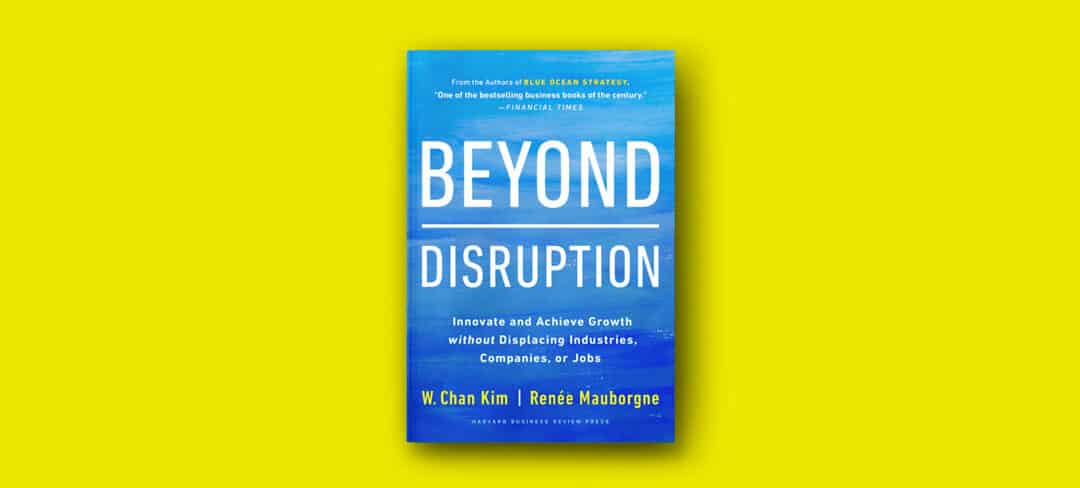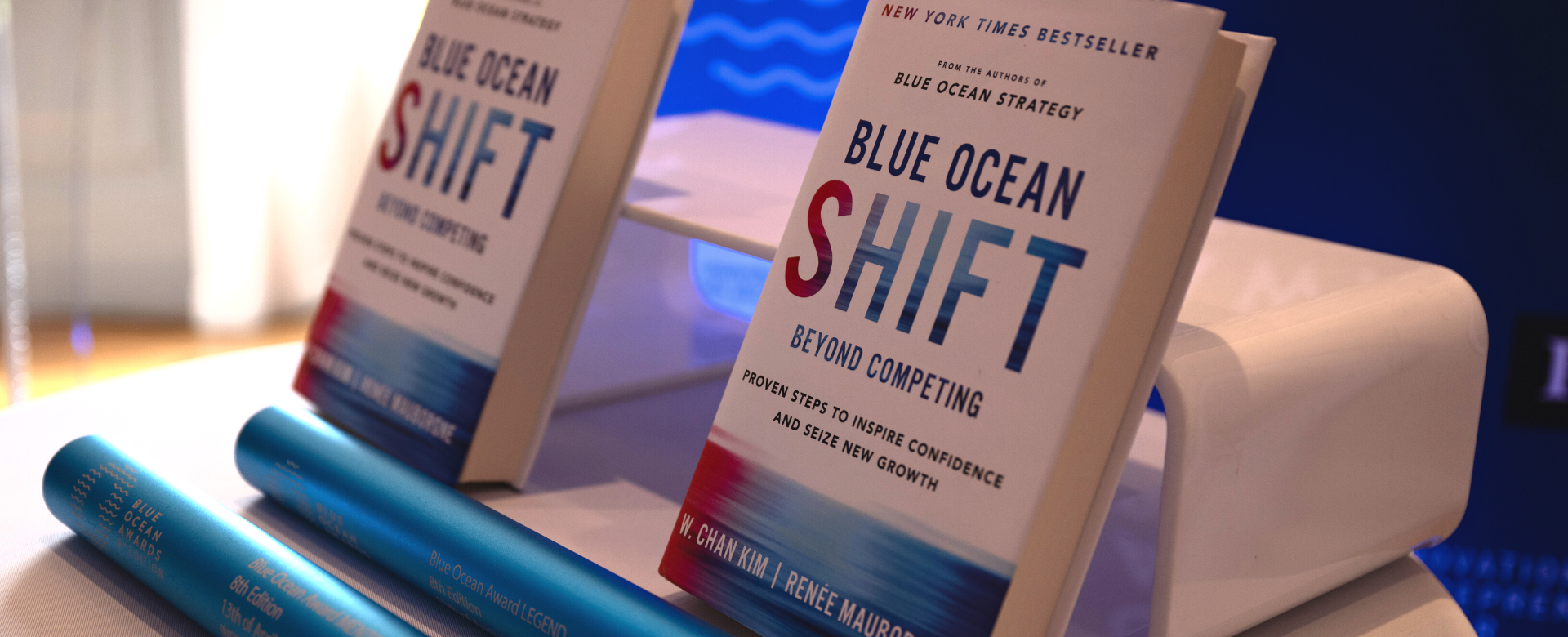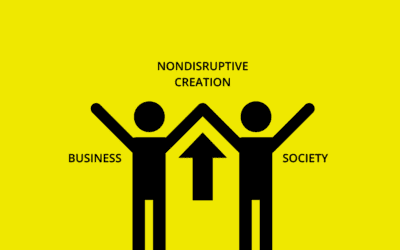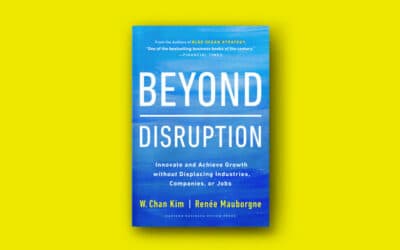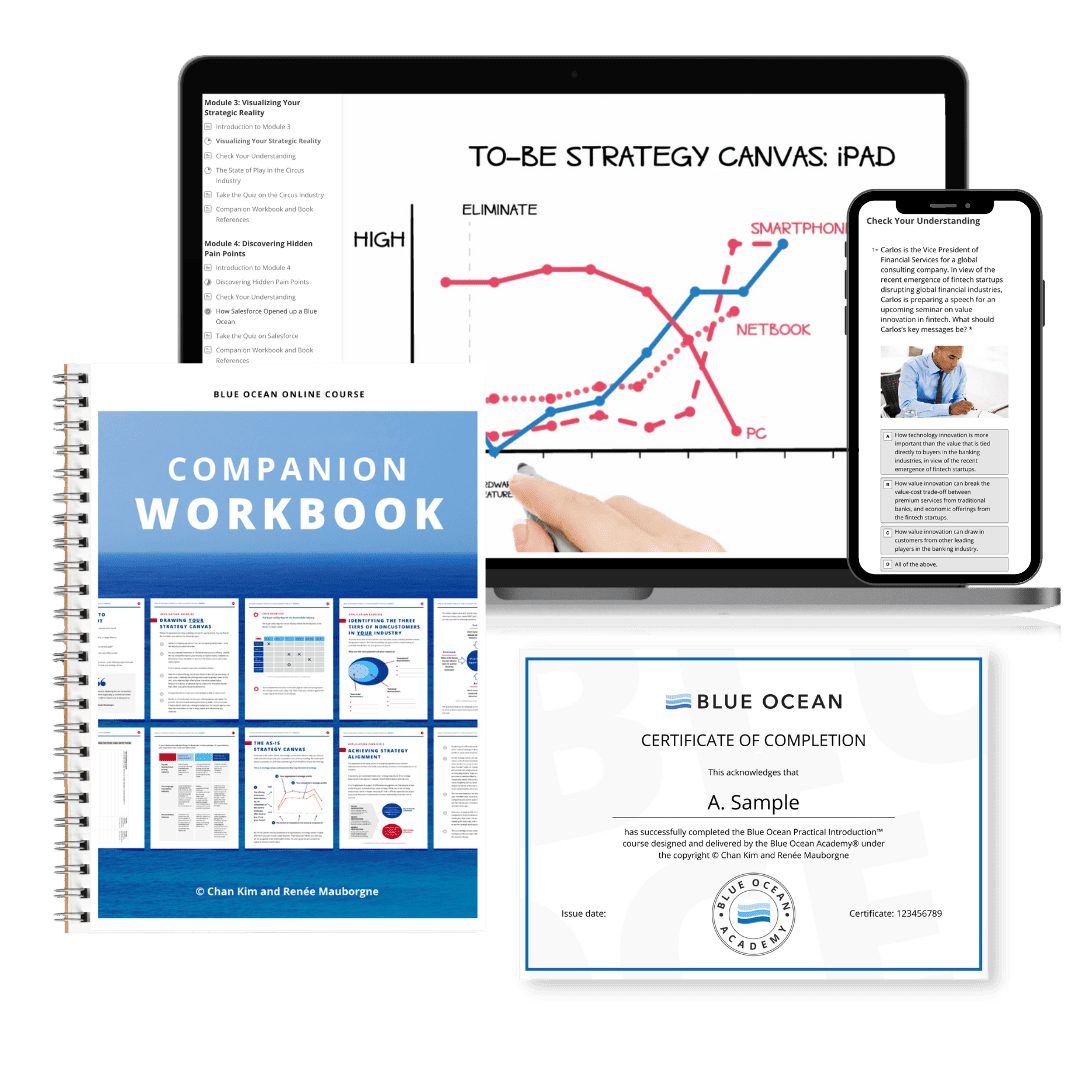Many people regard creativity as a mysterious and rare skill, a character trait that only a few people are born with, such as brilliant writers or ingenious entrepreneurs.
We beg to differ. We believe anyone can learn how to be creative. You don’t have to be a creative genius; you just need the right tools and process to create your blue ocean.
Blue ocean strategy shows you how to be creative in a way that counts and makes a difference to your team, your business, and your organization.
So whether you are born Steve Jobs or not, you too can be creative and make your mark on the world. We’ll show you how to be creative through the Six Paths Framework: six ways to help you unlock your creativity.
But first things first. What is creativity and why is creativity important?

You don’t have to be a genius to be creative. Learn how to be creative systematically in the Blue Ocean Strategy Online Course
What is creativity?
Ask Google what creativity is, and it will offer the following definition:
The use of the imagination or original ideas, especially in the production of artistic work.
We’re not going to argue with that except to add that creativity can manifest itself in a variety of ways, including work, business, and strategy, as well as painting, music, and the other arts.
Ever since Joseph Schumpeter wrote about the lone and creative entrepreneur, innovation and creativity have been thought of as a black box, unknowable and random. Not surprisingly, then, the field of strategy predominantly focused on analytic tools and frameworks to help companies compete in established markets.
But is creativity a black box? When it comes to artistic creativity or scientific breakthroughs – think Gaudi’s majestic art or Marie Curie’s radium discovery – the answer may be yes. But is the same true for the strategic creativity that opens up new market spaces? We’ll show you here how companies in various industries followed blue ocean strategic logic and a systematic process to be more creative and create blue oceans.

Gaudi’s Cathedral. Photo by Ashim D’Silva on Unsplash
Why creativity is important in business
The question ‘How to be more creative?’ does not get asked much in schools. Teachers and their students tend to focus on grades, facts, analysis, and getting the ‘right’ answers to exam questions.
It’s a similar story in the workplace. When was the last time you had professional training on how to be more creative? How many people even ask themselves, “How important is creativity in my job?”
And yet any organization, no matter the industry or area of work, can benefit from a more creative workforce. Businesses can generate unique and innovative solutions by encouraging employee creativity. Developing creative talents can help companies stand out from the competition and attract new buyers.
Most organizations today find themselves in this reality: intensifying competition, tighter profit margins, and supply exceeding demand in existing industries, or red oceans. New forces, such as the rising influence of social media megaphones that make it increasingly impossible for organizations to over-market their me-too offerings and the rising calls for creative solutions to burning new problems, make it more imperative for organizations to learn how to be creative.
Companies and organizations need to come up with more creative strategies that can unlock new demand and with them profitable new growth to thrive in the post-pandemic world.
And consider the benefits of being more creative for you personally. Creativity can help you solve problems more effectively in all aspects of your life and career. Your creative side can tackle business challenges from new perspectives rather than defaulting to a conventional red ocean or ‘me-too’ approach. A blue ocean process, in other words, can help you be more creative by allowing you to see things from a different perspective.
Creativity can also help develop your confidence. Perhaps you currently test random new business ideas in the hope of someday striking gold. How’s that going? What if, instead, you could unblock your creative pathways using a systematic process to discover insights that were once hidden from sight? As we shall see, a blue ocean approach to creativity will strengthen your creative competence and build confidence in your ability to uncover new and original ideas.
Don’t underestimate how creative and capable you and your team can be when you are actually given tools and a process that can teach you how to unlock that creativity, draw it out and direct it to growth opportunities. Random brainstorming does not cut it.

Creativity is important in business, and even more so in the post-pandemic era. Image from the Blue Ocean Online Course which will teach you how to be more creative.
How to be creative
Some of the most successful people are the most creative – think of Steve Jobs, JK Rowling, or Beyonce. Or think of someone you know personally who has achieved a lot in their personal lives or careers. You can probably see creativity at work in what they do.
You might think these people were born with creative skills, but what if that’s not the case. What if creativity could be learned?
Creativity starts with realizing that you do not have to accept things the way they are right now. You can change things. People can change too, by thinking differently and doing different things.
Blue ocean strategy provides you with the tools and frameworks to come up with creative ideas to stand apart. Let’s now take a closer look at this systematic process using the blue ocean six paths framework that will allow you to pull creativity and direct it to commercial opportunities.
How to be creative systematically? Watch the video from the Blue Ocean Online Course
How to become creative the blue ocean way
We believe that everyone has innate creativity and can create a blue ocean. But often people just don’t know how to tap into their reservoirs of creativity or their fear of failure and lack of confidence prevents them from exploring what’s possible. Blue ocean strategy empowers people with tools and frameworks and takes the process of creating new markets from a black box to giving simple tools and frameworks that anyone can use to think differently and in a creative way.
Developed by Chan Kim and Renée Mauborgne, professors of strategy and world-renowned management thinkers, blue ocean tools and concepts have creativity at their core. Why imitate what everyone else is doing? Why be another me-too company – or me-too anything – when you can create something new, original, and stand apart from the crowd?
Six ways to be creative in your industry
The six paths framework is a blue ocean tool that provides you with six systematic ways to think differently about your industry. It enables you to successfully identify out of the haystack of possibilities that exist, commercially compelling blue oceans. It helps demystify the creative work of seeing opportunities where others see only red oceans of competition.
Instead of looking within conventional boundaries, the six paths framework helps you look across alternative industries, across strategic groups, across buyer groups, across complementary product and service offerings, across the functional-emotional orientation of an industry, and even across time. Let’s take a closer look at each path with examples from different industries.
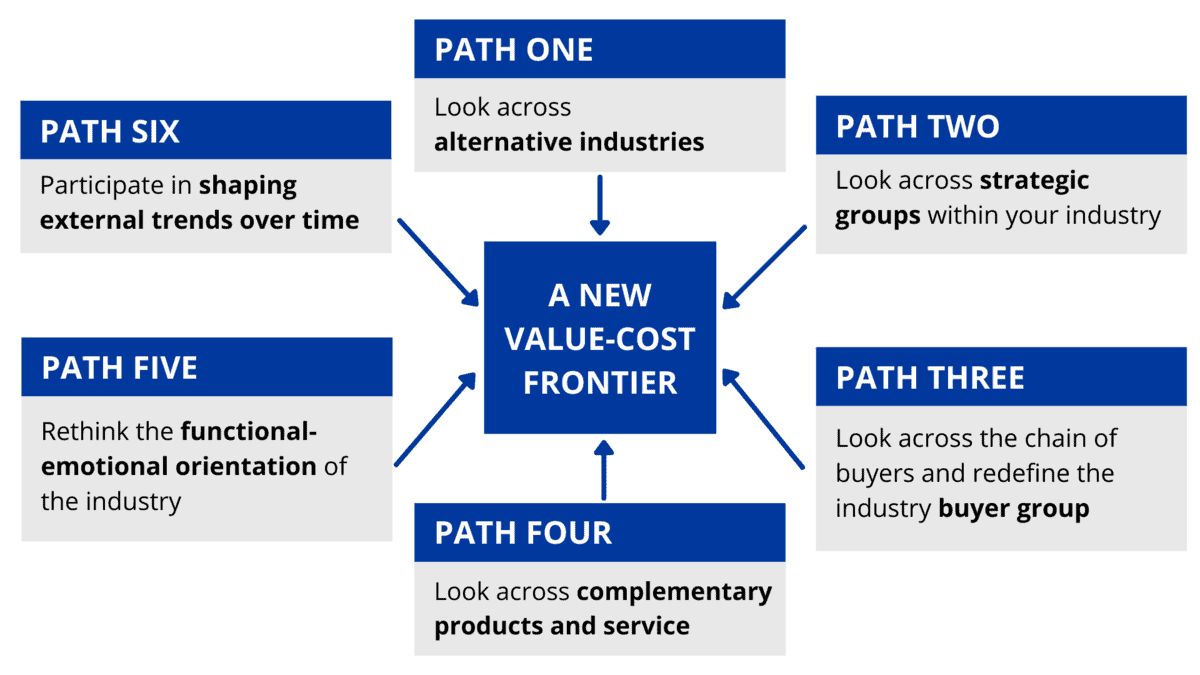
How to be creative systematically by using the six paths framework. © Chan Kim and Renée Mauborgne.
1 – Look across alternative industries
The first path to becoming more creative in your thinking involves looking across alternative industries for insights.
What are the alternative industries to your industry? Why do buyers trade across them?
Ask yourself, “If I were the buyer, what alternative industries would I consider before deciding to patronize our industry?’ Why would people choose an alternative industry over mine?”
By asking these questions, you are already thinking creatively and gaining insights into opportunities that others will miss.
You don’t normally think of the aviation industry as a creative one. Rather, the first thought that comes to mind is that the industry is hyper-competitive with low-profit margins and scant room for growth.
But one company made huge creative strides by looking across industry boundaries. NetJets, a private aviation company, observed that corporate travelers make up the most lucrative mass of customers in the aviation industry. NetJets realized that when business travelers want to fly, they have two alternatives. They can either fly business or first class on a commercial airline, or their company can purchase its own private jet for its travel needs. Why would corporations choose one alternative industry over another?
Commercial travel avoids the high up-front, fixed-cost investment of a multimillion-dollar jet aircraft. Also, a company purchases only the number of corporate airline tickets needed per year, lowering variable costs and reducing the possibility of unused aviation travel time that often accompanies the ownership of corporate jets. On the other hand, corporations buy private jets to dramatically cut total travel time, to reduce the hassle of congested airports, to allow for point-to-point travel, and to gain the benefit of having more productive and energized executives who can hit the ground running upon arrival.
By following this creative process of looking across two alternative industries, NetJets built on its distinctive strengths to give customers the convenience and speed of a private jet at the price of a first and business-class commercial airline ticket. By offering the best of commercial travel and private jets and eliminating and reducing everything else, NetJets opened up a multibillion-dollar blue ocean of fractional jet ownership. As a result of making this strategic move, its customers and noncustomers now have access to the largest private jet fleet in the world, without experiencing the complexities of owning an aircraft themselves.
NetJets created a blue ocean of fractional jet ownership in the aviation industry.
2 – Look across strategic groups within your industry
Another way to arrive at creative solutions is by looking across strategic groups within your industry or target industry. Just as you can create blue oceans by looking across alternative industries, you can also create new markets by looking across strategic groups. These are groups of companies within an industry that pursue a similar strategy, with most focusing on out-competing their rivals to improve their position within their strategic group or market segment.
The key to a blue ocean shift is to understand what factors determine buyers’ decision to trade up or down from one strategic group to another.
Let’s look at an example from the health management industry, a B2B industry that provides large corporations and insurance companies with health management services for employees’ health.
HealthMedia, a player in the industry with a revenue of US$5 million, was drowning in a red ocean of intense competition. At the time, the industry had two strategic groups, one offering telephonic counseling predominantly for severe medical conditions, the other offering generic, digitalized content like you find on WebMD.
HealthMedia explored why buyers traded across these strategic groups and found that despite all the factors players competed on, buyers traded up to telephonic counseling for one overriding reason – high efficacy – while they traded down to digitized content for low cost.
The companies competing in telephonic counseling were following a classic differentiation strategy, offering high efficacy through specialized counseling mainly for severe health challenges but at a higher cost. By contrast, those competing in digitalized content followed a classic low-cost strategy of offering generic health information at a low price but with low efficacy.
HealthMedia took a blue ocean approach to systematically unlock creativity and create growth. Instead of competing in either strategic group, it set out to break these trade-offs, creating new market space called digital health coaching, which combines the far lower cost of digitalized content with a leap in efficacy through interactive online questionnaires that digitally matched people’s self-reported challenges with a health plan that would work best for them.
Within just two years, HealthMedia had created a blue ocean so compelling that Johnson and Johnson swooped in and purchased the company for US$185 million.
3 – Look across the chain of buyers
Most industries converge around a common definition of their target customer. In reality, the purchasing decision usually involves – directly or indirectly – a chain of buyers. These are the users of the product or service; the purchasers who pay for it; and, in some cases, the influencers whose opinions can make the difference in a decision to purchase.
Bloomberg, the U.S.-based financial information, offers a classic example of how to be creative by looking across the chain of buyers and redefining the industry buyer group.
Until Bloomberg’s debut in the early 1980s, Reuters, Dow Jones, and Telerate dominated the online financial information industry, providing news and prices in real-time to the brokerage and investment community. The industry focused on purchasers —IT managers—who valued standardized systems, which made their lives easier.
Bloomberg saw that it was traders and analysts, not IT managers, who make or lose millions of dollars for their employers each day. When markets are active, traders and analysts must make rapid decisions. Every second counts.
So Bloomberg designed a system specifically to offer traders a leap in value, one with easy-to-use terminals and keyboards labeled with familiar financial terms.
Bloomberg could also see the paradox of traders’ and analysts’ personal lives. They have tremendous income but work such long hours that they have little time to spend it. As such, the company added information and purchasing services aimed at enhancing traders’ personal lives. Well before the internet offered such services, traders could use Bloomberg online services to buy items such as flowers, clothing, and jewelry; make travel arrangements; get information about wines, or search through real estate listings.
By thinking creatively and shifting its focus upstream from purchasers to users, Bloomberg created a blue ocean in the financial information services industry. In a little more than a decade, it had become one of the largest and most profitable business information providers in the world.

Bloomberg’s creativity created a blue ocean in the financial information services industry. Photo by Jeremy Bezanger on Unsplash
4 – Look across complementary product and service offering
Few products or services are used in a vacuum. In most cases, other products or services affect their value. Consider what happens before, during, and after your product and service is used. By broadening your understanding of the total solution buyers need or seek, you can often discover new opportunities to provide value.
Take the electric kettle industry in the UK. Although the electric kettle is central to the British public love of afternoon tea, the industry had become a veritable red ocean with low-profit margins and little growth. While the industry had long competed on price and aesthetic design, Philips Electronics shifted its focus to understanding the total buying process.
It discovered that the central challenge British tea drinkers faced had nothing to do with the kettle itself. It was the limescale in the municipal water. Before the tea drinkers could enjoy their freshly brewed tea, they often had to fish out the limescale floating within it in a spoon.
Kettle companies never thought to tackle the problem because it had nothing to do with their industry’s offering. But by thinking creatively and looking across the buyers’ experience, Phillips identified this block to utility and created a tea kettle with a changeable charcoal filter that remove the scale when the tea was poured.
The result: Phillips’s teakettle turned a slow-growth industry into a fast-growth one, lifted its price point, and created a new repeat revenue stream in changeable charcoal filters.
5 – Rethink the functional-emotional orientation of your industry
Competition in each industry or strategic group tends to converge, not only around an accepted view of the scope of an offering but also around the bases of its appeal. Some industries and groups compete principally on price and functionality – their appeal is functional. Others compete on generating positive feelings: their appeal is emotional.
A blue ocean can often be created by shifting the appeal of a product or service from one basis to another, or by blending the sources of its appeal.
An outstanding example of creativity in Pfizer’s wildly successful blue ocean strategic move that launched Viagra. Pfizer challenged the functional-emotional orientation of the pharmaceutical industry. It shifted its focus from a largely functional orientation – medical treatment – towards lifestyle enhancement – an emotional orientation.
Emotionally oriented industries offer many extras that add price without enhancing functionality. Stripping away those extras may create a fundamentally simpler, lower-priced, lower-cost business model that customers would welcome. Conversely, functionally oriented industries can often infuse commodity products with new life by adding a dose of emotion and, in so doing, can stimulate new demand.
When you are willing to challenge the functional-emotional orientation of your industry, you can often create new market space.

A series of blue ocean strategic moves at Apple, Inc transformed the company from a computer manufacturer into a consumer electronics powerhouse. Photo by surasak_ch on Unsplash
6 – Participate in shaping external trends over time
External trends affect every industry over time. Take the developments in technology and communications over the last 20 years. Or consider how the recent pandemic has affected and will continue to affect the way we lead our lives. Nowadays there is hardly a business, nonprofit, or government agency whose world is not being reshaped by external forces.
While you might be tempted to ask how to survive such rapid changes, the real question is how to be creative: how to unlock opportunities for growth that others are blind to.
Perhaps no company exemplifies this approach more than Apple. With the launch of iTunes, Apple unlocked a blue ocean of new market space in digital music that it has now dominated for more than a decade.
Apple observed the flood of illegal music file-sharing that began in the late 1990s, enabled by platforms such as Napster and Kazaa. By 2003 more than two billion illegal music files were being traded every month. While the recording industry fought to stop the cannibalization of physical CDs, illegal digital music downloading continued to grow.
With the technology out there for anyone to digitally download music free, the trend toward digital music was clear. This trend was underscored by the fast-growing demand for MP3 players that played mobile digital music, such as Apple’s hit iPod. Apple capitalized on this decisive trend with a clear trajectory with the creation of iTunes in 2003.
iTunes offered legal, easy-to-use, and flexible song downloads. By allowing people to buy individual songs and strategically pricing them far more reasonably, iTunes broke a key customer annoyance factor: the need to purchase an entire CD when they wanted only one or two songs on it.
iTunes also provided a leap in value beyond free downloading services via sound quality as well as intuitive navigation, search, and browsing functions.
The unprecedented value iTunes offered triggered customers the world over to flock to iTunes with recording companies and artists also winning. Today iTunes offers more than 37 million songs as well as movies, TV shows, books, and podcasts.
Check out our post, Think Different: Apple’s Blue Ocean Formula for Success, to find out how else Apple turned a systematic process to unlock creativity systematically.
Your next steps to becoming more creative
Read the classic and over-4.5-million-copy bestseller Blue Ocean Strategy and New York Times bestseller and the essential follow-up Blue Ocean Shift. The six paths frameworks is described in detail in the books among other tools that can boost your and your team’s creativity.
Not enough time to read the books? Take our online course instead. Train yourself and your team in creativity by taking the Blue Ocean Sprint online course. It will systematically help you become more creative in your work and life.
Top image of blue pencils by Lucas George Wendt on Unsplash









